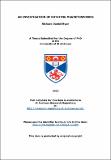Files in this item
An investigation of rotating magnetospheres
Item metadata
| dc.contributor.advisor | Neukirch, Thomas | |
| dc.contributor.author | Ryan, Richard Daniel | |
| dc.coverage.spatial | xi, 159 p. | en_US |
| dc.date.accessioned | 2017-07-26T14:11:20Z | |
| dc.date.available | 2017-07-26T14:11:20Z | |
| dc.date.issued | 2002-11 | |
| dc.identifier.uri | https://hdl.handle.net/10023/11294 | |
| dc.description.abstract | In this thesis we will construct simple models of rotating stellar and planetary magnetospheres within the framework of ideal MHD. These models will take the basic outline of a stellar magnetosphere that we have outlined above as a starting point from which to proceed further. In summary, this simple magnetosphere will be that of a single, rapidly rotating star' with an axisymmetric dipole magnetic field at the base of its corona and with an axis that is in alignment with that of the rotation axis. It is the isothermal plasma associated with this field that will give rise to the magnetospheric emission and which is held in strict corotation with the stellar surface. Equatorial and rotational symmetry reduce the domain to one quarter of a two dimensional quadrant. We will consider timescales that are much longer than the typical time scales of the system, which will allow us to model the evolution of the system quasi-statically by calculating sequences of MHS equilibria. This is achieved by numerical solution of the Grad-Shafranov equation (in terms of the flux function. A) Which requires us to specify a suitable surface pressure distribution and specify the toroidal component of the magnetic field as a function of A. The second chapter will outline the numerical procedure that will be employed to calculate these equilibrium sequences, and the practical realisation of this procedure. The third chapter will discuss different models which will be characterised by different surface pressure distributions but all of which will lack a toroidal magnetic field component. The fourth chapter will discuss results from a model which includes a toroidal magnetic field component. The models successfully reproduce the observed saturation and supersaturation of stellar emission with rotation. The fifth chapter will address the question of analytically constructing three dimensional equilibria that may be of use in the modelling of magnetospheres with magnetic field geometries that are not in alignment with their rotation axes or which are displaced from the centre of the rotating body, such as the giant gas planets Uranus and Neptune. The last section of the thesis will be a brief discussion of our conclusions, a review of the work of the thesis and will consider the outlook for further development, extension and refinement of our models. | en_US |
| dc.language.iso | en | en_US |
| dc.publisher | University of St Andrews | en |
| dc.subject.lcc | QA927.R9 | |
| dc.title | An investigation of rotating magnetospheres | en_US |
| dc.type | Thesis | en_US |
| dc.contributor.sponsor | Particle Physics and Astronomy Research Council (PPARC) | en_US |
| dc.type.qualificationlevel | Doctoral | en_US |
| dc.type.qualificationname | PhD Doctor of Philosophy | en_US |
| dc.publisher.institution | The University of St Andrews | en_US |
This item appears in the following Collection(s)
Items in the St Andrews Research Repository are protected by copyright, with all rights reserved, unless otherwise indicated.

